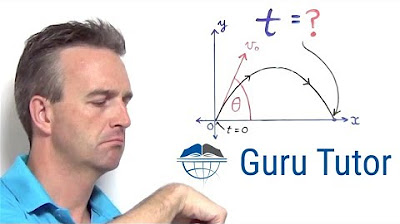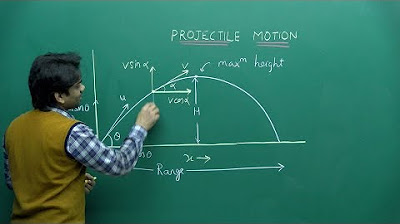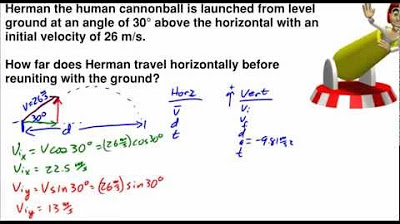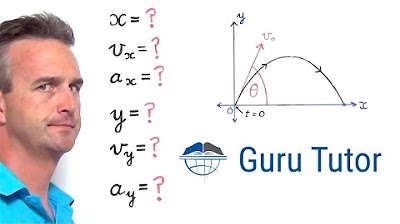Projectile Motion Maximum Height Formula Derivation
TLDRThis video script delves into the physics of projectile motion, focusing on deriving the formula for the maximum height attained by a projectile. It assumes prior knowledge of six basic projectile motion equations and the time-of-flight formula. The derivation process involves understanding the vertical component of velocity and its relationship with time and height. The final formula for maximum height is presented as the initial velocity squared times the sine of the projection angle squared, divided by 2g, highlighting the importance of initial velocity, angle, and gravity in determining the peak height of a projectile's trajectory.
Takeaways
- 📈 The maximum height (h_max) of a projectile is reached when the vertical velocity is zero.
- 🚀 The maximum height is at the midpoint of the projectile's trajectory, assuming no air resistance and that it's fired from ground level.
- 📐 The formula for the vertical component of velocity at any time (v_y) is used as a basis for the derivation.
- ⏳ The time at which the projectile reaches its maximum height (t_y_max) is when the vertical velocity becomes zero.
- 🔄 The time of flight for the entire projectile motion is twice the time it takes to reach maximum height (t_flight = 2 * t_y_max), in the absence of air resistance.
- 🌐 The symmetry of the projectile motion means that the time it takes to ascend is equal to the time it takes to descend.
- 📌 The formula for maximum height is derived by substituting t_y_max into the equation for vertical displacement (y).
- 🔢 The final formula for maximum height is given by: h_max = (V₀^2 * sin^2(θ)) / (2 * g), where V₀ is the initial velocity, θ is the angle of projection, and g is the acceleration due to gravity.
- 🔄 The derivation involves understanding the relationship between the vertical component of velocity and time, as well as the vertical displacement.
- 📊 The process of deriving the formula for maximum height demonstrates the application of kinematic equations in projectile motion.
- 🎓 It's important to have a solid understanding of the six basic projectile motion equations to follow this derivation.
Q & A
What is the maximum height attained by a projectile in the absence of air resistance?
-In the absence of air resistance, the maximum height attained by a projectile is exactly halfway between its firing point and where it lands.
What is the significance of the vertical component of velocity in projectile motion?
-The vertical component of velocity is crucial in determining the trajectory of the projectile. It changes direction from positive (upwards) during the ascent to negative (downwards) during the descent, and at the maximum height, the vertical component of velocity is zero.
How is the time at which the projectile reaches its maximum height related to the total time of flight?
-The time at which the projectile reaches its maximum height, denoted as t_yMax, is half of the total time of flight for the projectile motion.
What is the formula for the time of flight of a projectile?
-The time of flight formula for a projectile is derived from the vertical motion equations and is not explicitly given in the transcript. However, it is mentioned that it is related to the time at which the projectile reaches its maximum height.
How can we derive the maximum height formula for a projectile?
-We can derive the maximum height formula by setting the vertical component of velocity to zero (for the maximum height point) and using the equation for the vertical displacement at a given time. By substituting the values and simplifying, we obtain the formula for the maximum height.
What is the role of the initial velocity in determining the maximum height of a projectile?
-The initial velocity plays a significant role in determining the maximum height of a projectile. It directly affects the vertical component of velocity and, consequently, the height reached during the projectile's trajectory.
How does the angle of projection influence the maximum height of a projectile?
-The angle of projection influences the maximum height through its sine value. A higher angle (up to 90 degrees) typically results in a greater maximum height due to the increased vertical component of the initial velocity.
What is the impact of gravity on the maximum height of a projectile?
-Gravity acts as the force that pulls the projectile back down to Earth, affecting the vertical motion. It is included in the equations as a negative acceleration term, and its value (G) is used to calculate the maximum height.
What is the final formula for the maximum height attained by a projectile?
-The final formula for the maximum height (Y_max) is given by (V_not^2 * sin^2(theta)) / (2 * G), where V_not is the initial velocity, theta is the angle of projection, and G is the acceleration due to gravity.
Why is it important to understand the maximum height formula in physics?
-Understanding the maximum height formula is important as it provides insights into the motion of projectiles, which is fundamental in various applications such as sports, engineering, and military operations. It also helps in predicting and analyzing the behavior of objects moving under the influence of gravity and initial velocity.
How can the concepts from this script be applied in real-world scenarios?
-The concepts from this script can be applied in real-world scenarios like calculating the trajectory of a ball thrown in a game, determining the range of a projectile in military exercises, or even designing the trajectory of rockets and missiles in space exploration.
Outlines
🚀 Deriving the Formula for Maximum Height in Projectile Motion
This paragraph introduces the topic of deriving the formula for the maximum height attained by a projectile in the absence of air resistance. It emphasizes the importance of understanding the six basic projectile motion equations and the time-of-flight formula, which are prerequisites for this tutorial. The speaker explains that the maximum height is reached when the vertical component of velocity becomes zero, signifying the midpoint of the projectile's trajectory. The process involves substituting the condition of zero vertical velocity into one of the projectile motion equations to solve for the time at the maximum height (t_yMax). The explanation also connects this time value to half of the total time of flight for the projectile, highlighting the symmetry in projectile motion.
📈 Calculating the Maximum Height using the Vertical Displacement Equation
In this paragraph, the speaker continues the derivation process by focusing on calculating the maximum height using the vertical displacement equation. After determining the time at which the projectile reaches its maximum height (t_yMax), the speaker substitutes this time value, along with the initial vertical velocity (V_nought) and the angle of projection (theta), into the vertical displacement equation. The algebraic manipulation leads to the final formula for the maximum height, which is expressed as (V_nought^2 * sin^2(theta)) / (2 * g), where g represents the acceleration due to gravity. The paragraph concludes with a recap of the derived formula and an invitation for the viewers to apply it in their studies of projectile motion.
Mindmap
Keywords
💡Projectile Motion
💡Maximum Height
💡Velocity Component
💡Time-of-Flight
💡Acceleration Due to Gravity (g)
💡Initial Velocity (V_nought)
💡Angle of Projection
💡Symmetry
💡Trajectory
💡Derivation
Highlights
Introduction to deriving the maximum height attained by a projectile.
Assumption of familiarity with basic projectile motion equations.
Reference to the time-of-flight formula as a prerequisite.
Explaining the concept of maximum vertical height in projectile motion.
Analyzing the vertical component of velocity to find maximum height.
Point of zero vertical velocity at maximum height.
Derivation of time at maximum height (t yMax) using vertical velocity.
Correlation between time at maximum height and time of flight.
Reviewing the time of flight formula to validate the derivation.
Using the time at maximum height to find the vertical displacement.
Substituting time into the displacement equation to find maximum height (y max).
Simplification of the displacement formula to isolate y max.
Clarification of trigonometric operations in the derivation.
Final derivation of the formula for maximum height of a projectile.
Practical application and significance of the derived formula in physics.
Transcripts
Browse More Related Video

Projectile Motion Time of Flight Formula Derivation

PROJECTILE MOTION RELATED DERIVATIONS | TIME OF FLIGHT | HORIZONTAL RANGE | MAXIMUM HEIGHT | KANNADA

Time of Flight in Projectile Motion | Physics

NEET Physics | Projectile Motion | Theory & Problem-Solving | In English | Misostudy

Regents Physics: Angled Projectile Problem Practice

Deriving the 6 Basic Projectile Motion Equations
5.0 / 5 (0 votes)
Thanks for rating: